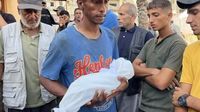At dawn on September 28, 2025, the Gaza Strip was once again rocked by a wave of violence, as Israeli forces launched a series of attacks that killed at least 40 Palestinians and wounded hundreds more, according to medical sources and Gaza’s Health Ministry. Among the dead were 10 displaced civilians in the Nuseirat refugee camp and 15 in Gaza City, with families caught in their homes during overnight airstrikes. The latest escalation underscores a conflict that has already left Gaza in ruins, as humanitarian conditions continue to deteriorate at an alarming rate.
The violence comes amid a flurry of diplomatic activity in Washington, where United States President Donald Trump and Israeli Prime Minister Benjamin Netanyahu met at the White House for the fourth time this year. The two leaders discussed a controversial new 21-point “day after” war plan for Gaza, first presented to Arab and Muslim leaders on the sidelines of last week’s United Nations General Assembly meetings in New York. The plan, which has been drafted in collaboration with Israel and an organization led by former UK Prime Minister Tony Blair, envisions a new international authority to govern Gaza after Hamas is ousted—a proposal that has already provoked fierce debate within Israel’s own political establishment.
But as political leaders debate the future, the present reality in Gaza is grim. According to Al Jazeera, the Health Ministry reported 77 deaths and 379 injuries in the past 24 hours alone, with two more bodies recovered from the rubble of earlier bombings. The cumulative toll since October 7, 2023, stands at 66,005 Palestinians killed and 168,162 injured. The numbers, though staggering, fail to capture the full human cost, as thousands are believed to be buried beneath debris, their fates unknown.
In the southern city of Khan Younis, the consequences of Israel’s blockade on food and medicine have become tragically clear. Nasser Hospital reported the death of two-and-a-half-month-old Eid Mahmoud Abu Jamma from malnutrition and lack of treatment. He is one of dozens of children who have starved to death this year, as Israel has severely restricted the entry of humanitarian aid into the enclave. Last week, Gaza’s Health Ministry reported 440 deaths from starvation and malnutrition, including 147 children. The Integrated Food Security Phase Classification (IPC) confirmed that, as of August 10, Gaza is experiencing phase 5 famine—the most severe category, marked by extreme food scarcity and high mortality risk. The IPC estimates that by the end of 2025, 132,000 Gaza children will suffer from acute malnutrition, with more than 41,000 facing severe, life-threatening conditions.
Medical professionals are sounding the alarm as they struggle to cope with the influx of casualties and the collapse of basic infrastructure. Muhammad Abu Salmiya, director of Gaza’s al-Shifa Hospital, described a desperate situation as Israeli tanks approach the facility and shelling continues nearby. “We are still providing medical services to the people of Gaza City, despite the ongoing invasion, the tanks approaching the hospital, and the continuous shelling,” Abu Salmiya told reporters. He warned that shutting down the hospital, already besieged and crippled by fuel shortages, would be “a catastrophe.” He added, “Hundreds of thousands of displaced people remain here, and if this hospital stops working, thousands will die.”
The violence has not spared children or families trying to flee. Civil defense and medical teams have struggled to reach victims in the Al-Nassr neighborhood, where heavy bombardment has made rescue efforts nearly impossible. In one tragic incident, Israeli forces attacked a family fleeing Gaza City, killing a six-year-old girl and wounding three other children. Across the enclave, Israeli forces continue to destroy infrastructure, residential buildings, and neighborhoods, further complicating efforts to deliver aid or rescue those trapped under rubble.
Meanwhile, the Euro-Mediterranean Human Rights Monitor has accused Israel of pursuing a “dangerous blackmail policy” against Palestinian families, forcing them to choose between collaborating with occupation forces or facing mass killing, starvation, and displacement. The rights group claims to have documented a shift from targeting individuals to exerting collective pressure on entire families to join local militias loyal to Israel. As an example, the Monitor cited the Bakr family massacre in Gaza’s Shati refugee camp, where nine members—including women and children—were killed after the family allegedly rejected an Israeli offer to remain in their home in exchange for forming a militia. The al-Deiri and Daghmash families reportedly received similar offers and faced intensified strikes after refusing to cooperate. The Monitor stated that such actions amount to “a full-fledged war crime” under the Rome Statute, which prohibits coercing civilians into collaboration with a hostile military force.
In the political arena, Netanyahu faces mounting pressure from both international allies and domestic rivals. The proposed “day after” plan for Gaza calls for Hamas to release all 48 remaining captives—about 20 of whom are believed to be alive—within two days. In exchange, Hamas fighters would be allowed to leave Gaza or be granted amnesty if they renounce resistance. The plan also promises significant humanitarian aid, the release of some Palestinian prisoners, and a gradual withdrawal of Israeli forces. Notably, it leaves the door open for a future Palestinian state and explicitly rejects the forced expulsion of Palestinians from Gaza, stating they will have a right of return if they choose to leave. This vision runs counter to the hardline positions of Netanyahu’s far-right coalition partners, including Finance Minister Bezalel Smotrich and National Security Minister Itamar Ben-Gvir, who have called for the destruction of Gaza, the prevention of any Palestinian state, and the rebuilding of Israeli settlements in the territory.
Netanyahu’s coalition is already on shaky ground. His Likud-led government currently holds only 60 out of 120 seats in the Knesset, making it a minority administration. Two major ultra-Orthodox parties have recently left the coalition over disputes regarding military conscription for religious students, and the far-right parties led by Smotrich and Ben-Gvir have threatened to topple the government if Netanyahu makes concessions to end the war without fully eliminating Hamas.
The proposed Gaza International Transitional Authority (GITA), which would administer Gaza after Hamas’s removal, is envisioned as a multinational body with an international board including UN officials, Egyptian businessmen, and Muslim representatives. Tony Blair is reportedly being considered to lead the entity. GITA would operate with a first-year management budget of $90 million, rising to $133.5 million and $164 million in subsequent years, not including the costs of reconstruction and humanitarian aid. Under the plan, a Palestinian technocratic authority would be appointed to implement governance on the ground, while a multinational stabilization force would control border crossings and security zones.
Despite the ambitious proposals, the Trump plan faces skepticism on all sides. Hamas stated that it had received no new proposal from mediators Egypt and Qatar but would consider a new offer to end the war. Meanwhile, ongoing Israeli military operations continue to claim civilian lives in Gaza and the West Bank, and Trump’s assertion that he will not permit the annexation of more territory remains to be tested.
As Gaza’s humanitarian crisis deepens and diplomatic efforts stumble, the people of the enclave are left to endure the daily realities of war, hunger, and displacement. The question of what comes next for Gaza grows ever more urgent, but for now, survival remains the only priority for its besieged population.






